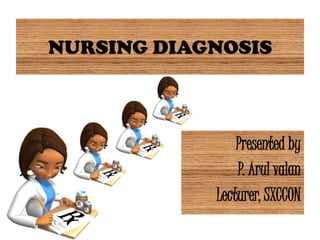Nursing diagnosis
- 1. NURSING DIAGNOSIS Presented by P. Arul valan Lecturer, SXCCON
- 2. Evolution of nursing process ŌĆó Fry (1953) identified that nursing diagnosis is a tool for individualizing patient care. ŌĆó First National Conference for the Classification of Nursing Diagnoses, (1973). ŌĆó American Nurses Association (ANA) published Standards of Nursing Practice (1973). ŌĆó North American Nursing Diagnosis Association (NANDA), 1982. ŌĆó NANDA developed 21 new nursing diagnoses and revised 37 existing diagnoses (1998).
- 3. Purpose of nursing process ŌĆó Identifies areas that nurses can resolve or enhance. ŌĆó Demonstrates professional judgment. ŌĆó Organizes decision making as part of the nursing process. ŌĆó Promotes accountability. ŌĆó Provides communication among nurses and other health care personnel. ŌĆó Promotes use of standardized language and process. ŌĆó A means to individualize care. ŌĆó Provides a mechanism for conducting nursing research.
- 4. Definition of a Nursing Diagnosis (NANDA, 1996) A nursing diagnosis is defined as ŌĆ£ a clinical judgment about an individual, family or community responses to actual and potential health problems/life processes. Nursing diagnosis provide the basis for selection of nursing interventions to achieve outcomes for which the nurse is accountable.ŌĆØ (NANDA, 2009)
- 5. Comparison of Medical and Nursing Diagnoses ŌĆó Medical diagnosis is the terminology used for a clinical judgment by the physician that identifies or determines a specific disease, condition, or pathologic state.
- 6. Nursing Diagnosis ŌĆó Terminology used for a clinical judgment by the professional nurse that identifies the clientŌĆÖs actual, risk, wellness, or syndrome responses to a health state, problem, or condition.
- 7. Components of a Nursing Diagnosis ŌĆó The two-part statement ŌĆō Problem statement or diagnostic label ŌĆō Etiology ŌĆó The diagnostic label and etiology are linked by the term related to (RT).
- 8. Components of a Nursing Diagnosis ŌĆó The three-part statement ŌĆō Diagnostic Label ŌĆō Etiology ŌĆō Defining Characteristics ŌĆó Defining characteristics are the signs and symptoms, subjective and objective data, or clinical manifestations. ŌĆó The phrase, ŌĆ£as evidenced by ŌĆ”ŌĆØ (AEB), is joined to the first two components.
- 9. Example of nursing diagnosis
- 10. Developing a Nursing Diagnosis ŌĆó Critical thinking ŌĆó Clustering cues ŌĆó Assessing the ŌĆó Consulting database NANDA list of nursing diagnoses ŌĆó Validating cues ŌĆó Writing the nursing ŌĆó Interpreting cues diagnostic statement
- 11. Types of nursing diagnosis ’āśActual Diagnoses(Three Part) ’āśRisk Diagnoses(Two Part) ’āśWellness Diagnoses(One Part)
- 12. Prioritizing nursing diagnosis ŌĆó Airway ŌĆó Breathing ŌĆó Circulation
- 13. Case study -1
- 14. Avoiding Errors in Developing a Nursing Diagnosis ŌĆó Accurate and complete collection of data. ŌĆó Use of an organizational framework for clustering data cues. ŌĆó Thorough analysis and validation of data. ŌĆó Correct writing of the nursing diagnosis.
- 15. Limitations of Nursing Diagnosis ŌĆó Lack of consensus among nurses regarding the NANDA-approved nursing diagnosis list. ŌĆó Nurses are overworked and have less time with clients. ŌĆó Care is still organized around the medical diagnosis.
- 16. Limitations of Nursing Diagnosis ŌĆó Nurses are afraid they may be ridiculed for using nursing diagnoses. ŌĆó The nursing diagnosis list does not always fit the client situation. ŌĆó Nurses may be unable or unwilling to use nursing diagnoses because of incomplete knowledge. ŌĆó If a nursing diagnosis is inappropriate, and as a result, the interventions are inappropriate or lacking, the nurse is liable for these errors in judgment.
- 17. Overcoming Barriers to Nursing Diagnosis ŌĆó Familiarity of nursing diagnosis language empowers the nurse to communicate more effectively. ŌĆó Health care agency administrators and medical staffs need to be more supportive of the use of nursing diagnoses.
- 18. Overcoming Barriers to Nursing Diagnosis ŌĆó Enhanced communication between clinical nurses and leaders will increase the development of nursing diagnoses. ŌĆó Most nursing education programs offer standardized content related to nursing diagnoses. ŌĆó Experienced nurses need opportunities to review nursing diagnoses.
- 19. Overcoming Barriers to Nursing Diagnosis ŌĆó Every attempt should be made to describe phenomena that do not fit into existing nursing diagnosis language. ŌĆó The nurse may be on the threshold of documenting a new nursing diagnosis.
- 20. ŌĆ£At the end of the day I can truly says I made a difference in someoneŌĆÖs life todayŌĆ”. And that is why I am NURSEŌĆØ




















